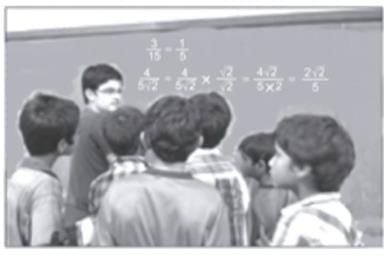Case Based Questions: Number System | Mathematics (Maths) Class 9 PDF Download
Case Study 1
During revision hours, two students Vimal and Sunil were discussing with each other about the topic of rationalising the denominator.
Vimal explains that simplification of √3 / (√5 + √3) by rationalising the denominator is multiplying numerator and denominator by (√5 - √3).

And Sunil explains the simplification of (√5 + √3)(√5 - √3) by using the identity (a + b)(a - b) = a² - b².
On the basis of the above information, solve the following questions:
Q 1. The rationalising factor of √5 + √3 is:
a. 1 / (√5 + √3)
b. (√5 - √3)
c. -√5 - √3
d. (√5 + √3)
Q 2. According to Vimal explanation, the simplification of √3 / (√5 + √3) is:
a. (5 - √15)
b. (5 + √15) / 2
c. (√15 - 3) / 2
d. 5 + √15
Q 3. According to Sunil explanation, the simplification of (√3 + √2)(√3 - √2) is:
a. 1
b. -1
c. 2
d. 3
Q 4. Addition of two irrational numbers:
a. is always rational
b. is always irrational
c. may be rational or irrational
d. is always integer
Q 5. The square root of natural number is a/an:
a. rational
b. irrational
c. rational or irrational
d. None of these
Solutions
1. (b) The rationalising factor of (√5 + √3) is (√5 - √3).
So, option (b) is correct.
2. (c) We have, √3 / (√5 + √3)
By rationalisation the denominator
√3 / (√5 + √3) = √3 / (√5 + √3) × (√5 - √3) / (√5 - √3)
= (√3(√5 - √3)) / ((√5)² - (√3)²)
= (√3√5 - √3√3) / (5 - 3)
= (√15 - 3) / 2
So, option (c) is correct.
3. (a) Using identity (a + b)(a - b) = a² - b²
Therefore (√3 + √2)(√3 - √2) = (√3)² - (√2)²
= 3 - 2 = 1
So, option (a) is correct.
4. (c) Addition of two irrational numbers may be rational or irrational.
e.g. (2 + √5) + (1 - √5) = 3, which is rational.
(ii) (2 + √5) + √3 = 2 + √5 + √3, which is irrational.
So, option (c) is correct.
5. (c) The square root of a natural number is a rational or irrational number.
So, option (c) is correct.
Case Study 2
One day a math teacher taught students about the number system. She drew a number line on the black board and represented different types of numbers such as natural numbers, integers, rational numbers, etc.  A number of the form p/q is said to be a rational number, if q ≠ 0 and p and q are integers.On the basis of the above information, solve the following questions:
A number of the form p/q is said to be a rational number, if q ≠ 0 and p and q are integers.On the basis of the above information, solve the following questions:
Q 1. A rational number between 1/3 and 1/7 is:
a. 21/5
b. 17/21
c. 5/21
d. 5/21
Q 2. An irrational number between √3 and √5 is:
a. 2.1
b. √3.5
c. 3.5
d. √7
Q 3. Decimal number 1.5 in the form of p/q is:
a. 14/9
b. 11/9
c. 14/9
d. 11/9
Q 4. The sum of two rational numbers is always:
a. integers
b. naturals
c. rational
d. irrational
Q 5. A terminating or repeating decimal number is a/an:
a. rational
b. irrational
c. rational or irrational
d. whole number
Solutions:
1. (d) A rational number between 1/3 and 1/7 is
1/3 + 1/7 = (7 + 3) / (2 × 21) = 10 / 42 = 5 / 21
So, option (d) is correct.
2. (c) Since, √3 = 1.732 and √5 = 2.236
But √3.5 = 1.870, which lies in the given interval.
Hence, irrational number √3.5 lies between √3 and √5.
So, option (c) is correct.
3. (d) Let x = 1.5
⇒ x = 1.555... ...(1)
Multiplying both sides by 10, we get
10x = 15.55... ...(2)
Subtracting eq. (1) from eq. (2), we get
9x = 14 ⇒ x = 14 / 9
So, option (d) is correct.
4. (c) The sum of two rational numbers is always a rational number.
So, option (c) is correct.
5. (a) A terminating or repeating decimal number is a rational number.
So, option (a) is correct.
|
40 videos|471 docs|57 tests
|
FAQs on Case Based Questions: Number System - Mathematics (Maths) Class 9
| 1. What is the number system and why is it important in mathematics? |  |
| 2. Can you explain the different types of numbers in the number system? |  |
| 3. How do rational and irrational numbers differ from each other? |  |
| 4. What are the properties of numbers in the number system? |  |
| 5. How can understanding the number system aid in problem-solving in mathematics? |  |
















